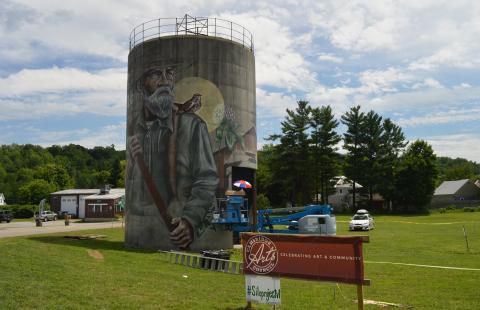What were the specific goals of this creative economy project? Describe the community development challenge or opportunity that your project was designed to address:
Our goals before starting this project are outlined below:
The future of Cambridge and Jeffersonville includes bringing to fruition the vision of residents developed through the recent Vermont Council on Rural Development Community Visit process to improve economic development, increase resources for the aging population and create a community center that would benefit residents of all ages—from the very young to the elderly.
This project would help realize the community’s visions by shifting the perception of both visitors and residents traveling on Route 15 to Jeffersonville away from what, at first glance, looks a bit like a wasteland anchored by gas stations and a couple of commercial properties selling alcohol, car repairs and construction, to one of a community of creative, committed residents and business owners who take pride in their town. The painted silos would attract the attention of motorists, pedestrians and cyclists and instill the idea that people here take pride in the town and are invested in its beautification and improvement. With plans already being developed for creating a public park on the property, improving the ‘walkability’ of the streets and connecting the downtown to the Lamoille Valley Rail Trail, the beautification of the silos would add to the appeal to take the roads into the downtown to dine, shop and explore the treasures there such as the Bryan Memorial Gallery, Visions of Vermont Fine Art Galleries and the restaurants, stores, library, historical buildings and more.
Success of the project would be realized by the interest from the community to come together to contribute ideas for the artwork to grace the silos; to support the project with in-kind and financial contributions and to plan for the sustainability of the work.
If the goals change over time, please describe how:
Our goals stayed intact throughout the process and were realized more vibrantly throughout due to criticism in our selection and the project as a whole.
Who was involved in this project and what did they do? (be sure to include the partners from outside of the creative sector and how local voices were included):
We worked with dozens of individuals and companies throughout the entire process, including local government, neighbors, community boards, etc. Each had a role (some even a negative role) in our process and execution. Within the creative sector, we had a much smaller group of partners. This project truly spanned across multiple demographics with varying backgrounds and stakes.
How does this project relate to a larger community development strategy?
The former Bell-Gates property was a lumber yard for many decades in the 20th century in the Village of Jeffersonville (Town of Cambridge). For the past 15+ years, since the closing of the lumber mill, the property has sat vacant. As years progressed, parts of the mill were destructed until just an overgrown field with two concrete silos remained. In times of flooding, which Cambridge and Jeffersonville endure at least once a year, the field is basically underwater.
In 2012, Jolley Gas Stations purchased the land with the plans to construct a gas station and fast food business on the land. Due to outcry from residents, the Village of Jeffersonville Board of Trustees began the process of purchasing the land from Jolley to prevent their development plans, which would have worsened the flood situation. The residents and municipal boards decided to take matters into their own hands. On September 29, 2014, after more than two years of fundraising, lawsuits, and hoop-jumping, the Village of Jeffersonville became the owners of the property.
As the first thing you see when entering the village from the north or east (Bakersfield, Waterville, Johnson), the silos in their former state reminded locals of a defunct business and industry, and tourists saw abandoned infrastructure. What we envisioned was the beautification of the silos via a 360° mural on each, which incorporated the surrounding beauty and unique landscape of our town (i.e. covered bridges, working farms, Mt Mansfield, Brewster & Lamoille Rivers, Smugglers’ Notch, etc.). By having these structures as a showcase for art, locals and tourists alike will see that we care about our town, are proud of it, and that the arts are an important part to our community.
